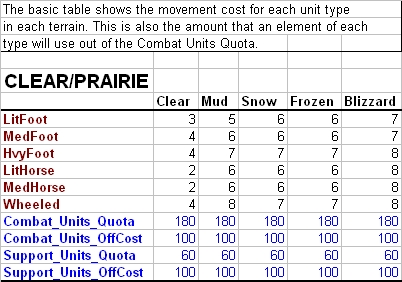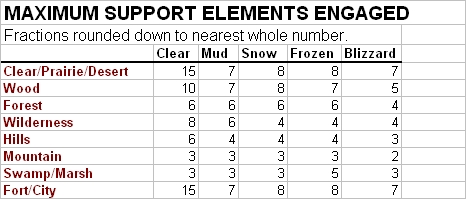Due to a sudden burst in spammer activity, account creation has been temporarily disabled. Sorry for the inconvenience to any new potential contributors.
Frontage
From AGEWiki
In military terminology, "frontage" refers to the amount of space a unit tales up along a line of battle. In AGE games frontage refers to the limitation on the number of units that can be deployed on the battlefield.
Depending on the terrain and weather conditions, an army is limited in the number of troops that can be engaged. Units that move slowly will also maneuver slowly and so cannot be as readily deployed. Troops that are not engaged are held in reserve and can be sent in to relieve broken units. The game engine handles all of these details invisibly during combat resolution, but it's important to know how the system works so that you can adjust your tactics accordingly.
See also: Combat Explained
Contents |
Combat Units Quota
For each terrain type, there is a Combat Units Quota and a separate Support Units Quota which limits the number of combat and support elements on each side that can engage in combat during a single combat round (the quota covers all units participating in the combat, not separately computed for each division or stack). The quotas are unaffected by weather, except in the case of cities and forts, where for some reason they are somewhat reduced in clear weather.
Important: for purposes of frontage, artillery is considered a support unit, so it fills up the Support Units Quota.
Quota Costs
Each type of element will use up a set amount of the Combat Units Quota (or Support Units Quota) for each element added to the combat. This amount is affected by weather, with harsh weather generally increasing the amount of the quota that an element will use, thereby reducing the number of elements that can engage in combat.
The quota cost for each type of element is taken from the base unmodified movement cost for the specific type of element in the specific type of terrain. (e.g., cavalry are especially slow in mud, so fewer of them can be deployed).
Assigning to Combat
The game engine will randomly assign elements to be engaged in combat until the Combat Unit Cost Quota and the Support Unit Cost Quota are both filled or it runs out of elements. This process is repeated for each combat round.
The chance of a particular element being engaged is modified by:
- Whether the unit is already engaged (big increase in chance to be engaged again).
- If not already engaged, the number of hits (i.e., health) an element has (e.g., militia have lower total hits than line infantry so are less likely to be engaged).
- If routed, chance to be picked is reduced.
There is no precedence advantage for different types of elements, and no bonus if you have just one of something (like a sharpshooter), but the element’s special ability will still apply to its unit even if not engaged (first fire for sharpshooter).
If supply wagons are present, the game engine will not assign more than one supply element to combat as long as there are other types of support elements (e.g., artillery) available to fill the Support Units Quota.
Modifiers
A few specific terrain/weather combinations subtract -25% from the quotas for units in offensive posture only (so the attacker can employ fewer elements than the defender):
- Wilderness/Hills/Mtn/Swamp/Marsh in Mud or Blizzard weather.
- Fort and City in all weather.
In open terrain only (clear/prairie/desert/wood), the Units Quotas are modified by leader (rank)*(offensive/defensive rating) depending whether in offensive or defensive posture:
- Combat Units Quota: (+25 points)*[(rank)]+(off/def rating)]
- Support Units Quota: (+10 points)*[(rank)]+(off/def rating)]
The leader bonus comes from the senior general in command. This bonus can be HUGE. A mediocre 1* general with 1 off/def would get a +50 bonus, while a 2* general with a 3 off/def would get a +150 bonus (+60 for support units), so he could bring about 60% more infantry elements to the fight, and twice as much artillery!
Other Notes
Elements from the same unit will all fire against the same enemy unit. If they have overwhelming firepower and destroy the enemy unit outright, the excess firepower for the round is “wasted” and not redirected at another enemy unit. With multiple divisions engaged, you may only see casualties in one because the enemy’s fire was all directed at the same unit.
Corps support artillery (unassigned to divisions) will fire on the healthiest (i.e., strongest) enemy unit. This may not be the same unit that it is directly opposed against.
Notes on Terrain/Weather/Unit Type Combinations
There are literally hundreds of different combinations of terrain/weather/unit type. Here are some general comments:
- Cavalry have a big frontage advantage over infantry in clear/city/fort terrain + clear weather, but not in any other conditions, and they especially don’t like mud.
- Forts and cities have the lowest quotas (Forts are somewhat better) and they also impose a -25% quota penalty on the attacker.
- Light infantry have the lowest all around frontage cost, especially in rough terrain and harsh weather.
Effects of weather and terrain
Simply check the Terrain modding-file. Right beneath the frontage-points, you can find the effects in the excel-lines 43-84; from top to bottom the values refer to: regulars, irregulars, militia, cavalry, artillery, supply, warships. Each category has 6 lines: ATKFire (ranged-combat-factor for elements on an aggressive stance), DEFFire (ranged-combatfactor for elements on defensive stance), ATKProt (Protection factor for elements on offensive stance), ATKDef (Protection factor for elements on defensive stance), ATKTQ & DEFTQ (Effect on Total Quality (aka "Discipline")).
So, e.g. consider a battle in the "wilderness" on a rainy day ("mud"). You're in command of irregulars, whereas the enemys force consists entirely of cavalry. Each side has 96 frontage points at its deposal (not counting any bonus from officers and the like...). However, as light foot only needs 10 days to enter wilderness/mud, you can deploy 9,6 elements on the battlefield, whereas the enemy can only deploy 4,8 elements (horse need 20 days to enter wilderness/mud). Moreover, your irregulars get a 20% fire bonus and a +2 protection bonus (and a +1 melee bonus?)! The cavalry, on the other hand is at -50% fire, -1 protection and -1 melee!

